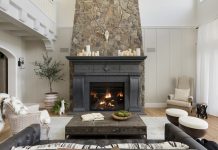
This new house is larger than its neighbors in Minneapolis’s Linden Hills and isn’t the same style as any of them, but savvy design by Rehkamp Larson Architects makes it feel right at home. Bringing the roof gable down scales the house to its neighbors. Details such as chunkier window frames and porch posts echo those of the older houses, and the materials are tried and true. The house won a 2010 Blend Award given for Minneapolis residential designs that respect their context. Photo by Ken Gutmaker
The teardown phenomenon has reached the boiling point in southwest Minneapolis—as it did a year ago in Edina. And it’s just beginning to heat up in St. Paul’s Highland Park neighborhood.
Residents complain that quiet neighborhoods look like war zones, with bulldozers poised on one side of the street and concrete mixers whirling away on the other. And they fear that gigantic new houses will loom over the modest bungalows and ramblers of an earlier era, rending the fabric of the places where they love to live.
Angst over untamed construction and loss of neighborhood character reached such a level this spring that the Minneapolis City Council slapped a yearlong moratorium on building in a large swath of south and southwest Minneapolis. It was quickly rescinded after the adoption of a 25-point construction management agreement that aims to blunt the impact of demolishing, digging, and constructing inches from neighboring houses. The city also will consider zoning changes to address overscaled and poorly designed new homes.
But are new houses or substantially enlarged ones in older neighborhoods necessarily a blight? Not at all.
Drive through the wonderfully settled neighborhoods of south Minneapolis, Edina, and St. Paul, and you will see charming new and remodeled houses that slip comfortably into the fabric of their blocks. You may not even be able to tell if a house is new or old, renewed or original.
It’s not rocket science, say the architects who design them. It’s sensitive, thoughtful design based on long-standing principles.

The house features an open kitchen with granite-topped island for food preparation and family gathering. Photo by Ken Gutmaker.
Start with the context
While a zoning code sets out basic requirements about how much can be built on a lot, how tall it can be, and how close it can be to its neighbors, it doesn’t necessarily guarantee that what is built fits in with its neighbors.
“A zoning code is a blunt force,” says Andrew Edwins of Peterssen/Keller Architecture of Minneapolis. A successful design requires a more nuanced approach.
“First we look at the site and its pluses and minuses,” says Dan Nepp of TEA2 Architects in Minneapolis. “Where does daylight come from? What are the neighbors? What is their scale? Where are they on the site?
“And we look not just at the immediate neighbors. What is the fabric of the block? Are there detached garages, front porches? How much variety is there? What is the kind of rhythm?”
Nepp and his partners typically measure the height of neighboring houses. Other firms conduct equally extensive investigations. Before designing a new house in the tony White Oaks neighborhood of Edina, Jean Rehkamp Larson of Rehkamp Larson Architects did a massing study of the adjacent houses, measuring eave heights, looking at rooflines, and documenting the materials. Designer David Heide of David Heide Design Studio often analyzes photos of the entire block.
“Look at how the house will look from the other side of the street,” Heide says. “Look at the bigger picture and how you fit it.”

The mudroom ensures that everything is in its place. Photo by Ken Gutmaker.
Speak the language
Architects who have studied historic architecture and worked on older homes seemed to have imbibed the rules used over time to make coherent, livable designs.
“Whether a house is Craftsman or Tudor or Art Deco, you start to learn what we call the rules—the canon,” says Lars Peterssen of Peterssen/Keller. “Some are very style-driven. Others, like the typical Minneapolis Foursquare house built in the 1910s and ’20s, aren’t high-style, but they still have rules.”
This set of rules didn’t come about because of zoning codes, he says: “It came about because of a sense of tradition and community responsibility over 100 years of building—and also making homes that work in this climate—with a pitched roof for the snow and a plot of land around them.”
He says what’s happening now is “that there are a lot of developers building spec homes, and they don’t have architects involved and they don’t know the canon. They maximize the volume and stick on details willy-nilly.”
Or, as Heide puts it: “Each house has a design vocabulary—a language of massing, rhythm, proportion, scale of windows—that is its style. When we’re adding on to a house, we’re looking to understand that language and speak more of it.”

What a difference 200 square feet can make! SALA Architects added both character and space to a 1920s Tudor house in St. Paul with a gabled bump-out for a new kitchen and mudroom. The seamless addition borrowed rooflines, traditional double-hung windows, and details such as brackets from the existing house. The old kitchen was remodeled as a bedroom, creating a house that accommodates one-level living. Photo by Daniel Nordstrom.

South light pours through the windows of the new kitchen. The gabled roof, brackets, and half-timber touches scale the new entry to the existing house. Photo by Daniel Nordstrom.
Consider Reusing
Teardowns are understandable. The 800-square-foot saltboxes and 1,000-square-foot ramblers of the 1940s and ’50s don’t fit today’s lifestyles.
“We live differently than when these homes were built; the kitchen was isolated, there was no mudroom,” says Joseph Metzler of SALA Architects in Minneapolis. “People prefer houses that are traditional in style but like open floor plans. Individual rooms don’t work today.”
Many designers and remodelers specialize in reworking the layouts of vintage houses: taking down walls, adding on at the back, or pushing the roof up to allow a second story. Even a small addition at the back or opening up the wall between the kitchen and dining room can totally change the way the house lives, Metzler says: “I just think most people give up on old homes too quickly.”

The 1940s Cape Cod in Edina was outdated, but TEA2 Architects suggested remodeling on the existing footprint rather than tearing it down. They made the roof steeper, added dormers, and widened the garage to create room for a second-floor master bedroom and bath. Shingles, double-hung windows, and the new door and roof canopy lend charm to the exterior while maintaining the architectural style. Photo courtesy of TEA2 Architects.

The remodel added 465 square feet without pushing the house too close to its neighbors. Opening the dining room to a new terrace transformed the once-dark interior. Photo by Susan Gilmore.
Scale Down
And, if the decision is to build new, it doesn’t have to loom.
“We look at massing to maximize the living space inside while minimizing its impact on the exterior,” says Metzler.
It’s kind of a game of “sleight of eye.” Pull a gable roof down. Add dormers. Push the front of the house back from the setback and create a front porch or entry. Put the entry on the side. Animate a façade with windows. Don’t be greedy by building to all the setbacks.
“Do anything that’s not a box,” says Nepp. “And that always creates more appealing spaces inside as well.”
Whether sensitive design can be regulated is unclear. But it clearly can be achieved.
“We’re very much on the same team with the city,” says Mark Larson of Rehkamp Larson. “We want sensitive infill. That keeps the city alive and neighborhoods vibrant.”
By Linda Mack
Architects: Jean Rehkamp Larson and Ryan Lawinger, Rehkamp Larson Architects
Builder: J. S. Johnson & Associates
Architects: Dan Nepp and Rachel Hendrickson, TEA2 Architects
Builder: Bill Pohlen Wipo, Inc.
Architects: Paul Buu, and Bryan Anderson, SALA Architects
Builder: Home Tailors.

















